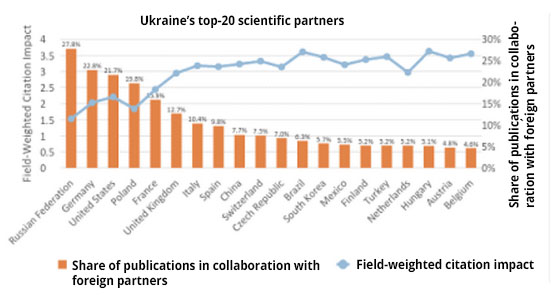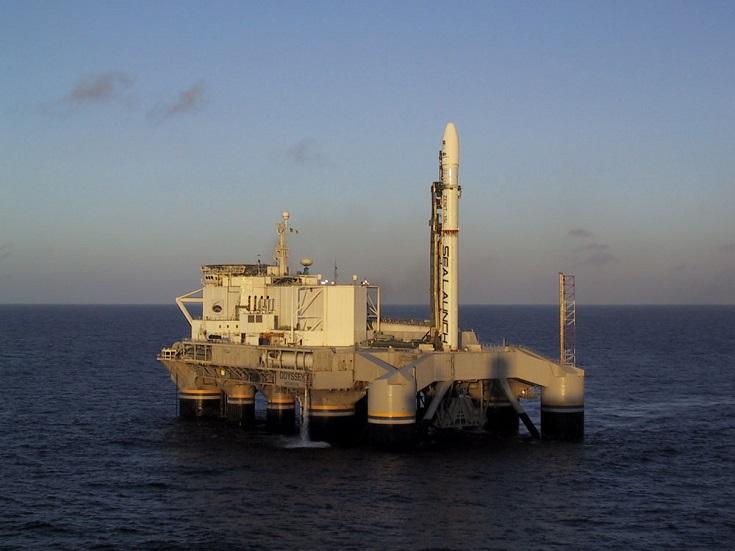Usually, any comparison between Ukraine with the developed world are dismal: our GDP is smaller; corruption is more rampant—to be found everywhere from the plumber to the Prime Minister; the standard of living is near the bottom. How are things in the world of science? We will attempt to assess the situation and make recommendations on what to do.
We believe there are several relevant criteria for assessing scientific output:
The Nobel Prize. Ukraine has no formal winners of this award – at least not yet. By comparison, Ireland has six Nobel Prize winners, whereas neighboring Poland and Hungary have 12 and 9 laureates, respectively.
Publications: articles, monographs, books and patents. This criterion, of course, measures noncommercial and fundamental research, that is, research on which taxpayer money is spent. Moreover, the total quantity of publications is not necessarily the best measure of scientific advancement.
In today’s globalized world, science in Ukraine can best be considered in the context of global trends and developments. In our analysis we used Scopus, the world’s largest database of scientific publications. It includes over 21 000 scientific journals from around the world, including 60 proprietary Ukrainian publications. To qualify for this database, entries must meet minimum criteria of quality, including being peer-reviewed and having a minimum number of English-language titles and summaries.
General trends and quantitative indicators
Quantitatively, the number of published articles in various scientific journals has been steadily increasing over the past two decades, from approximately 6,000 to nearly 10,000 per year. In general, publications with respect to the natural sciences and mathematics dominate: Physics and Astronomy, Engineering, and Materials add up to more than half of the total scientific publications (Fig. 1). Significantly, according to Scopus, approximately 40% (11 658 out of 28 353) of all publications from 2012-2014 had at least one author from the National Academy of Sciences of Ukraine.
The situation depicted in the chart above is noticeably different from current global trends, where more attention is given to medicine and biology and social sciences. It should be noted that research in the field of medicine has a direct relationship with the quality of health care, because, among other things, medical research is frequently done in universities by qualified professors, and as a result, there are more good doctors.
The dominant areas of scientific research vary from one country to another. Fig. 2 shows topics of scientific publications in the EU, where the trends of global scientific research are fully reflected..
Scientific and technological research in Ukraine has not advanced consistently: over the past twenty years, Ukraine’s share in the world’s scientific publications fell from approximately 0.5% to almost 0.3% (at the same time, Ukraine’s GDP has been slightly less than 0.2% of that of the rest of the world). The situation in recent years has begun to improve due to increased funding, at least nominally (with a lag of several years) – see Fig. 3. The low point in Ukrainian financing for the sciences came in 2000. Since 2001, funding for science has been increasing. Although the lowest number of scientific publications occurred in 2009-2010, such a delay is typical for research projects because they usually take several years to complete.
It is important to note that Ukraine’s GDP in this period grew faster – the funding of science fell from 1.36% of GDP in 1996 to 0.81% in 2013. In the EU the average was 1.92% of GDP (even in Poland, it was 0.87%, and in Russia, 1.12%).
Here lies the answer to the question of how the underground economy hurts us in the long run. Half of the Ukrainian economy is in the shadows, which means half the country’s potential tax revenues are lost and, accordingly, governmental budget expenditures across the board are diminished. Governmental sources, of course, are a major source of funding for scientific research in Ukraine as well as the rest of the world. Significantly, the loss of tax revenues today, and the resulting diminished spending on science, creates a widening deficit of scientic advances into the future because scientic advances build on each other.
Since 2015 Ukraine has been a full-fledged partner in the recently launched pan-European program Horizon 2020; therefore, there is a new opportunity to integrate Ukrainian science into a world-wide network through international cooperation.
Ukraine’s science was pretty much isolated from the rest of the world up till the mid-2000’s. After that, indicators of international cooperation in Ukrainian research approached those in the US and the EU. So, in 2014 Ukrainian scientists have published 38% of total articles in collaboration with scientists from other countries, and in 1996 – only 20%. The most significant scientific partner of Ukraine is still Russia, with a small lead over Germany, the USA and Poland. For comparison, here are statistics for the countries shown for the years 2012-2014 (fig. 4).

At the same time, the rate of Ukrainian international cooperation in research differs drastically, depending on the field, which affects the quality of published articles. For instance, the share of articles published in co-operation with foreign researchers in economics, econometrics and finance, and social science was only 4.7% and 15%, respectively.
Performance research
The ratio of patents per year per million of private investment to the index are virtually identical in Ukraine and the United States, which once again confirms that Ukraine has all opportunities for successful development.
Despite the fact that the general quantitative indicators of Ukrainian science look pretty good, qualitative indicators show the depth of the problem. The easiest comparison is the overall economic viability of the country and its scientific achievements, measured in the number of published works and results. At first glance, Ukraine is in the trend: “little money – few results”. However, things look much worse if we look at individual productivity – namely, the average number of articles published by one scholar in internationally recognized journals (those 60 journals that are published in Ukraine are included here, too):
The individual productivity of research in Ukraine is approximately ten (10!) times lower than the average individual productivity in developed countries. This is the obvious consequences of reducing the funding of science. Ukraine needs either to raise its spending tenfold or lay off 9 of 10 scientists to release the necessary resources for those who remain, so they have the opportunity to work on a global level.
The problem of low labor efficiency in Ukraine was discussed earlier, but for the labor of scientists it is particularly acute. According to the law of averages by Jim Rohn, “we are the average of five people with whom spend most of our time;” therefore, “if no one around me works, neither will I.” […]
However, private investments into research are proving to be effective. According to Espacenet, 32 000 Ukrainian patents were registered in 2012-2014; for the US, there were 370 000 patents. Ukraine’s ranking in the comparative level of private investment in research, published by the World Economic Forum in the Global Competitiveness Index is calculated as 3.1, whereas for US it is 5.5. The ratio of patents per year per million of private investment to the index are virtually identical in Ukraine and the United States, which once again confirms that Ukraine has all opportunities for successful development.
What is the quality of Ukrainian research?
One of the recognized methods of assessing the impact, novelty, and the importance of a publication is the so-called impact-factor. This methodology is based on the assumption that the higher the quality of an article or outcome the more likely it will be quoted in other publications. Therefore, the more links to an article, the more influential it is, or the greater impact it has.
We compared the average impact factor of Ukrainian publications to publications of different country groups. The average impact factor of all the world’s publications is always 1.

Both Ukraine, as well as other CIS countries, have a lower-than-average impact factor. Part of the reason is the low number of Ukrainian publications that appear in top academic journals. In Ukraine, only 12.3% of the articles are published in journals which are considered to be in the top-10% of their disciplines. In the EU, that figure is at 30% while in the US it is nearly at 40%.
Given the low efficiency and low public funding of Ukrainian science, it’s no surprise that the greater the degree of international cooperation, the more chances to get the best results and recognition. After all, only the competitive projects find partners and obtain financial support from outside Ukraine. On average, all articles published in collaboration with foreign partners have impact above 1 (Fig. 7).

Such a connection is fairly clearly observed in all branches of science. The greater the level of international cooperation, the quality of the published works is above average.
What should be done?
Most importantly, the work efficiency of scientists should be improved. This is not a new problem, but it is the main obstacle on the path of Ukrainian science. In particular, we offer:
First, to increase competition among universities and research institutions through:
- The financial independence of universities;
- A clear division of public financing of education research;
- The introduction of clear indicators of quality performance for three five-year periods, which will be based on well-established international figures, such as Scopus
Second, to drastically reduce the number of scientific institutions and universities, and to undertake an overdue reform of the Academy of Sciences. Ukraine will not be able to maintain such a bloated structure.
Third, to continue the course of integrating with the European Research Area and participate in solving the greatest challenges of our time.






